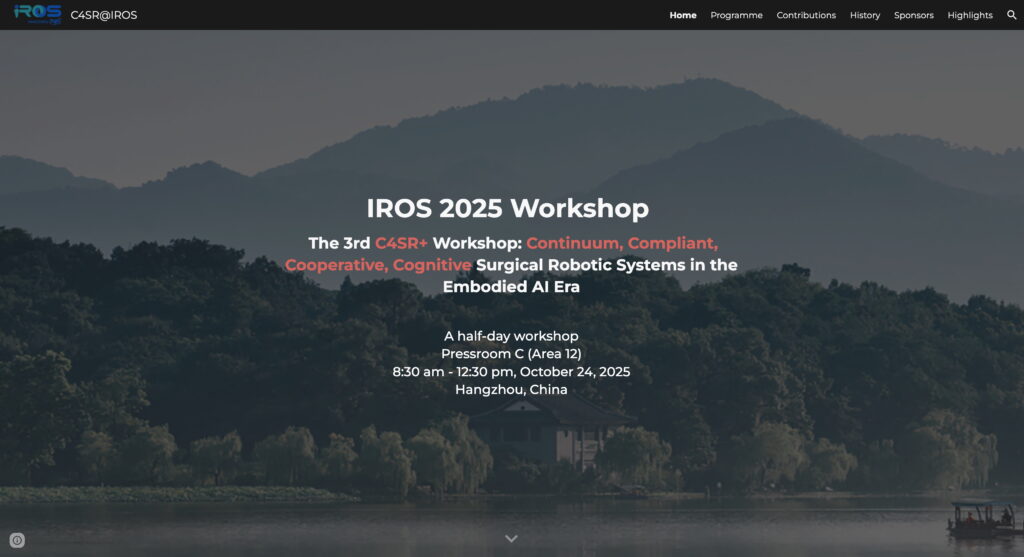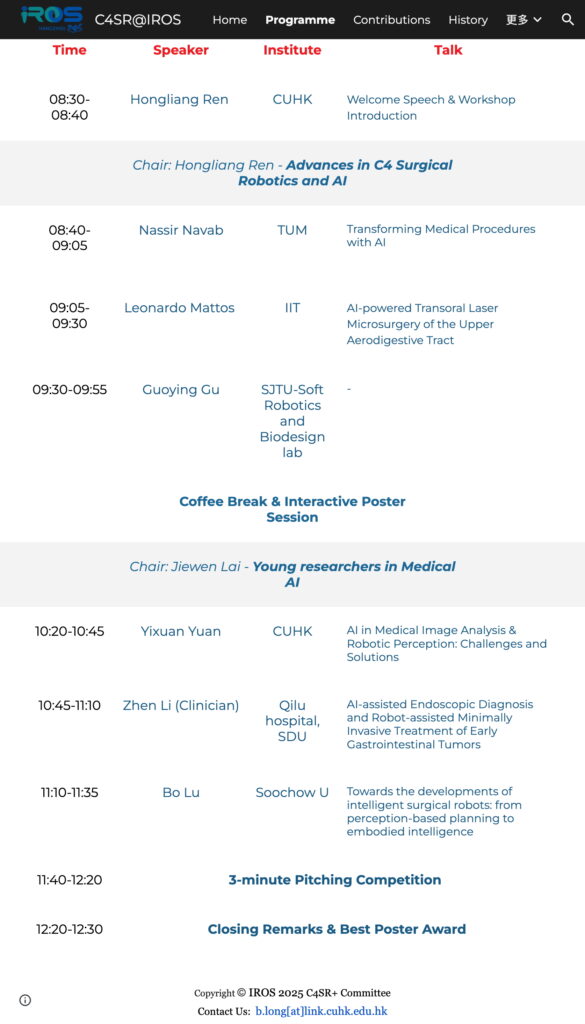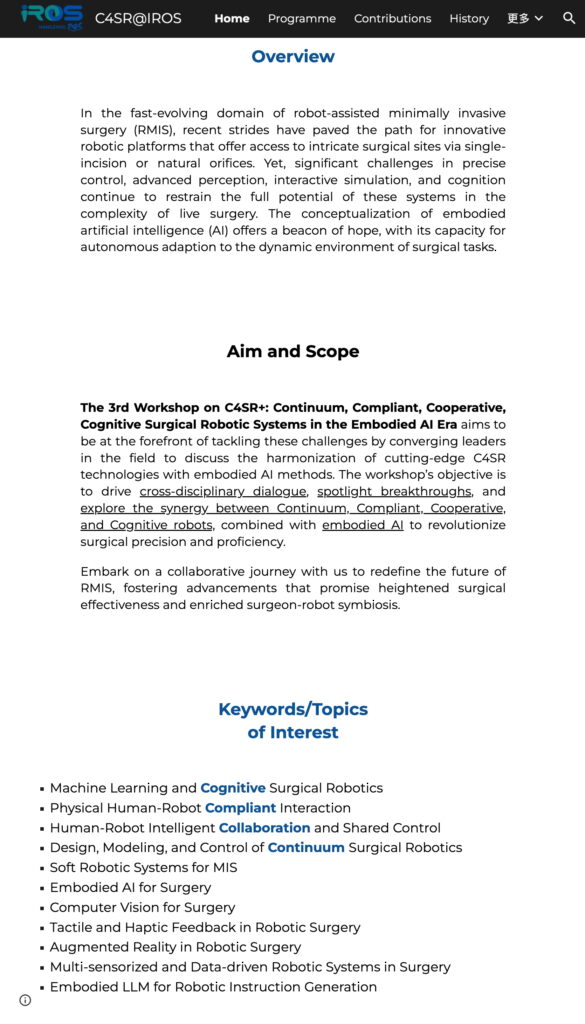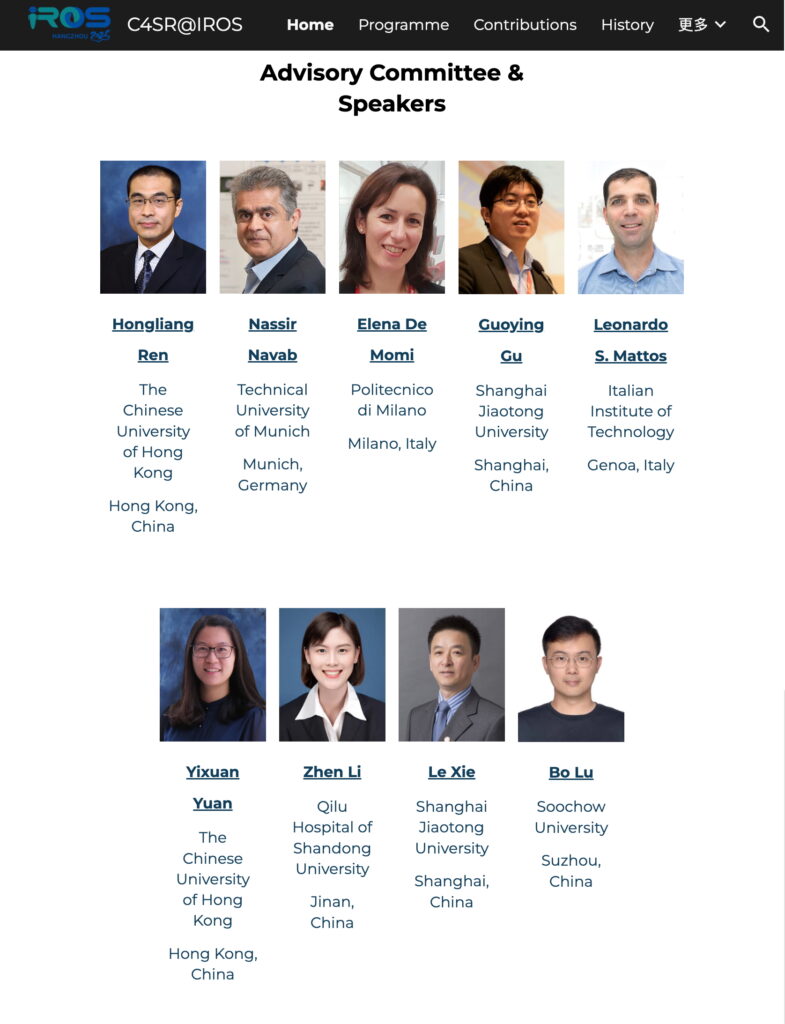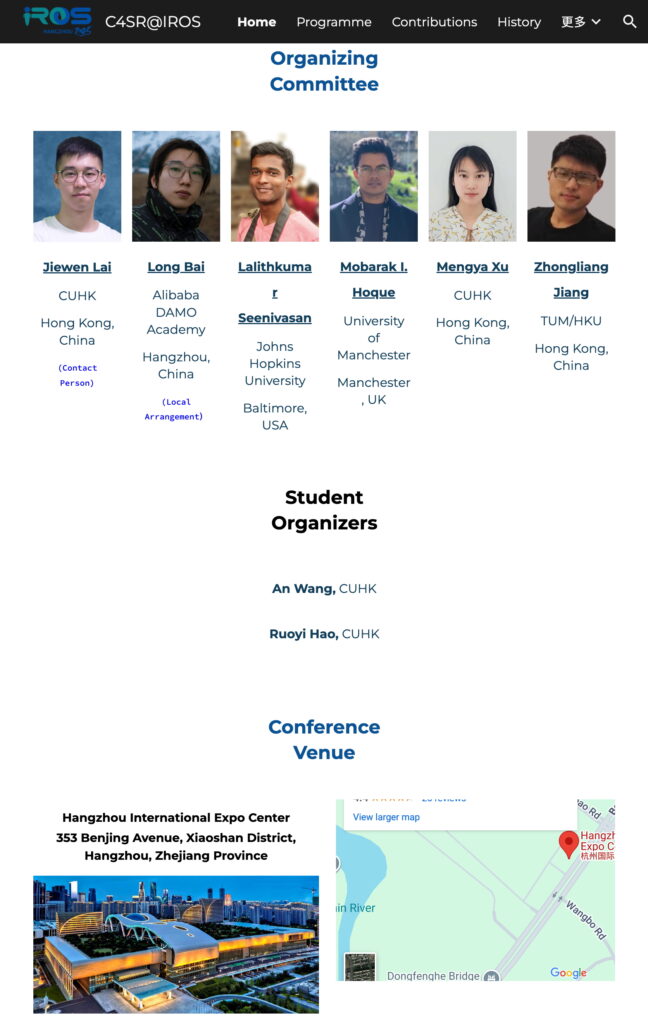The 3rd C4SR+ Workshop: Continuum, Compliant, Cooperative, Cognitive Surgical Robotic Systems in the Embodied Al Era.
Category: News
🎙️ Prof. Hongliang Ren presented at the 6th CCF China Intelligent Robot Academic Annual Meeting, sharing insights on “𝗠𝗼𝘁𝗶𝗼𝗻 𝗚𝗲𝗻𝗲𝗿𝗮𝘁𝗶𝗼𝗻 𝗮𝗻𝗱 𝗣𝗲𝗿𝗰𝗲𝗽𝘁𝗶𝗼𝗻 𝗼𝗳 𝗙𝗹𝗲𝘅𝗶𝗯𝗹𝗲 𝗥𝗼𝗯𝗼𝘁𝘀 𝗶𝗻 𝗠𝗶𝗻𝗶𝗺𝗮𝗹𝗹𝘆 𝗜𝗻𝘃𝗮𝘀𝗶𝘃𝗲 𝗜𝗻𝘁𝗿𝗮𝗰𝗮𝘃𝗶𝘁𝘆 𝗦𝘂𝗿𝗴𝗲𝗿𝘆”.
🧠 𝗧𝗮𝗹𝗸 𝗛𝗶𝗴𝗵𝗹𝗶𝗴𝗵𝘁𝘀:
The presentation explored the challenges and opportunities in motion generation and perception for flexible robots operating in minimally invasive surgical environments. Prof. Ren emphasized the importance of image-guided robotic systems in enhancing surgical precision, flexibility, and repeatability—while acknowledging the complexities these systems introduce in development.
He shared recent advances from our lab in intelligent motion planning and perception, aiming to enable smart micro-imaging and guided robotic interventions. The proposed remote robotic system is tailored for surgical applications, empowering clinicians with multi-modal sensing and continuous motion generation for dexterous operations.


🚀Excited to share that our paper “𝐄𝐧𝐝𝐨𝐕𝐋𝐀: 𝐃𝐮𝐚𝐥-𝐏𝐡𝐚𝐬𝐞 𝐕𝐢𝐬𝐢𝐨𝐧-𝐋𝐚𝐧𝐠𝐮𝐚𝐠𝐞-𝐀𝐜𝐭𝐢𝐨𝐧 𝐌𝐨𝐝𝐞𝐥 𝐟𝐨𝐫 𝐀𝐮𝐭𝐨𝐧𝐨𝐦𝐨𝐮𝐬 𝐓𝐫𝐚𝐜𝐤𝐢𝐧𝐠 𝐢𝐧 𝐄𝐧𝐝𝐨𝐬𝐜𝐨𝐩𝐲” has been accepted to the Conference on Robot Learning (𝐂𝐨𝐑𝐋) 2025!
In this project, we tackled the unique challenges of robotic endoscopy by integrating vision, language grounding, and motion planning into one end-to-end framework. EndoVLA enables:
– Precise polyp tracking through surgeon-issued prompts
– Delineation and following of abnormal mucosal regions
– Adherence to circumferential cutting markers during resections
We introduced a dual-phase training strategy:
1. 𝐒𝐮𝐩𝐞𝐫𝐯𝐢𝐬𝐞𝐝 𝐟𝐢𝐧𝐞-𝐭𝐮𝐧𝐢𝐧𝐠 on our new 𝐄𝐧𝐝𝐨𝐕𝐋𝐀-𝐌𝐨𝐭𝐢𝐨𝐧 dataset
2. 𝐑𝐞𝐢𝐧𝐟𝐨𝐫𝐜𝐞𝐦𝐞𝐧𝐭 𝐟𝐢𝐧𝐞-𝐭𝐮𝐧𝐢𝐧𝐠 with task-aware rewards
This approach impressively boosts tracking accuracy and achieves zero-shot generalization across diverse GI scenes.
The paper is available at: https://lnkd.in/g35DF7Fq


🎉 Excited to share that our paper “𝐂𝐨𝐏𝐄𝐒𝐃: 𝐀 𝐌𝐮𝐥𝐭𝐢-𝐋𝐞𝐯𝐞𝐥 𝐒𝐮𝐫𝐠𝐢𝐜𝐚𝐥 𝐌𝐨𝐭𝐢𝐨𝐧 𝐃𝐚𝐭𝐚𝐬𝐞𝐭 𝐟𝐨𝐫 𝐓𝐫𝐚𝐢𝐧𝐢𝐧𝐠 𝐋𝐚𝐫𝐠𝐞 𝐕𝐢𝐬𝐢𝐨𝐧-𝐋𝐚𝐧𝐠𝐮𝐚𝐠𝐞 𝐌𝐨𝐝𝐞𝐥𝐬 𝐭𝐨 𝐂𝐨-𝐏𝐢𝐥𝐨𝐭 𝐄𝐧𝐝𝐨𝐬𝐜𝐨𝐩𝐢𝐜 𝐒𝐮𝐛𝐦𝐮𝐜𝐨𝐬𝐚𝐥 𝐃𝐢𝐬𝐬𝐞𝐜𝐭𝐢𝐨𝐧” has been accepted to 𝐀𝐂𝐌 𝐌𝐌 𝟐𝟎𝟐𝟓 (𝐃𝐚𝐭𝐚𝐬𝐞𝐭 𝐓𝐫𝐚𝐜𝐤)!
We built 𝐂𝐨𝐏𝐄𝐒𝐃 to help AI better understand surgical workflows—especially the complex motions involved in 𝐄𝐧𝐝𝐨𝐬𝐜𝐨𝐩𝐢𝐜 𝐒𝐮𝐛𝐦𝐮𝐜𝐨𝐬𝐚𝐥 𝐃𝐢𝐬𝐬𝐞𝐜𝐭𝐢𝐨𝐧 (𝐄𝐒𝐃). The dataset includes:
📹 35+ hours of annotated surgical videos
🖼️ 17,679 labeled frames
🔍 88,395 motion annotations across multiple levels
We designed a hierarchical annotation scheme to capture fine-grained surgical motions, especially focusing on the submucosal dissection phase. Our goal is to enable 𝐯𝐢𝐬𝐢𝐨𝐧-𝐥𝐚𝐧𝐠𝐮𝐚𝐠𝐞 𝐦𝐨𝐝𝐞𝐥𝐬 that can one day assist surgeons in real-time—like a smart co-pilot in the OR.
Thanks to all collaborators (Guankun Wang, Han Xiao, Huxin Gao, Renrui Zhang, Long Bai, Xiaoxiao Yang, Zhen Li, Hongsheng Li,
Hongliang Ren) and institutions (CUHK, Shanghai AI Lab, Qilu Hospital of SDU) involved. We’re excited to see how this dataset can push forward research in 𝐬𝐮𝐫𝐠𝐢𝐜𝐚𝐥 𝐀𝐈, 𝐫𝐨𝐛𝐨𝐭𝐢𝐜𝐬, and 𝐦𝐮𝐥𝐭𝐢𝐦𝐨𝐝𝐚𝐥 𝐥𝐞𝐚𝐫𝐧𝐢𝐧𝐠.
📄 Check out the paper: https://lnkd.in/gkF6A4QY



🎉 Excited to share that our paper “𝑅𝑒𝑡ℎ𝑖𝑛𝑘𝑖𝑛𝑔 𝐷𝑎𝑡𝑎 𝐼𝑚𝑏𝑎𝑙𝑎𝑛𝑐𝑒 𝑖𝑛 𝐶𝑙𝑎𝑠𝑠 𝐼𝑛𝑐𝑟𝑒𝑚𝑒𝑛𝑡𝑎𝑙 𝑆𝑢𝑟𝑔𝑖𝑐𝑎𝑙 𝐼𝑛𝑠𝑡𝑟𝑢𝑚𝑒𝑛𝑡 𝑆𝑒𝑔𝑚𝑒𝑛𝑡𝑎𝑡𝑖𝑜𝑛” has been accepted by 𝐌𝐞𝐝𝐢𝐜𝐚𝐥 𝐈𝐦𝐚𝐠𝐞 𝐀𝐧𝐚𝐥𝐲𝐬𝐢𝐬 (IF 11.8)!
In this work, we tackled the challenge of training models that can keep learning new surgical instruments over time, without forgetting the old ones. Data imbalance made this especially tricky, so we proposed a plug-and-play framework that balances the data using inpainting and blending techniques, and introduced a new loss function to reduce confusion between similar-looking tools.
Big thanks to our amazing team (Shifang Zhao, Long Bai, Kun Yuan, Feng Li, Jieming YU, Wenzhen Dong, Guankun Wang, Prof. Mobarak I. Hoque, Prof. Nicolas Padoy, Prof. Nassir Navab, Prof. Hongliang Ren) from CUHK, TUM, Strasbourg, and UCL. This collaboration truly brought together ideas from different corners of the world 🌍
The paper is now online: https://lnkd.in/gemZFNUK Code coming soon 👨💻
📢 𝐂𝐚𝐥𝐥 𝐟𝐨𝐫 𝐏𝐚𝐩𝐞𝐫𝐬: 𝐈𝐂𝐁𝐈𝐑 𝟐𝟎𝟐𝟓 | 𝐀𝐮𝐠𝐮𝐬𝐭 𝟐𝟔–𝟐𝟖, 𝟐𝟎𝟐𝟓 | 𝐙𝐡𝐚𝐧𝐠𝐲𝐞, 𝐆𝐚𝐧𝐬𝐮, 𝐂𝐡𝐢𝐧𝐚
Join us in the breathtaking landscapes of 𝐙𝐡𝐚𝐧𝐠𝐲𝐞, China for the 𝟐𝟎𝟐𝟓 𝐈𝐧𝐭𝐞𝐫𝐧𝐚𝐭𝐢𝐨𝐧𝐚𝐥 𝐂𝐨𝐧𝐟𝐞𝐫𝐞𝐧𝐜𝐞 𝐨𝐧 𝐁𝐢𝐨𝐦𝐢𝐦𝐞𝐭𝐢𝐜 𝐈𝐧𝐭𝐞𝐥𝐥𝐢𝐠𝐞𝐧𝐜𝐞 𝐚𝐧𝐝 𝐑𝐨𝐛𝐨𝐭𝐢𝐜𝐬 (𝐈𝐂𝐁𝐈𝐑), an affiliated event of the 𝐐𝟏 Elsevier journal 𝐁𝐢𝐨𝐦𝐢𝐦𝐞𝐭𝐢𝐜 𝐈𝐧𝐭𝐞𝐥𝐥𝐢𝐠𝐞𝐧𝐜𝐞 𝐚𝐧𝐝 𝐑𝐨𝐛𝐨𝐭𝐢𝐜𝐬 (IF 5.4).
We welcome original contributions covering:
• Biomimetic design, materials & actuation
• Bio-inspired sensing, perception & navigation
• Learning-based control & embodied AI
• Soft & adaptive robotics
• Novel real-world applications integrating theory and practice
All accepted papers will be published by Elsevier and indexed in EI & Scopus. Top-ranked submissions will earn best-paper awards and invitations to submit expanded versions to Biomimetic Intelligence and Robotics and other leading journals.
𝐊𝐞𝐲 𝐃𝐚𝐭𝐞𝐬 • Full-Paper (or Short Abstract) submissions due → July 20, 2025 • Acceptance notifications → August 1, 2025 • Registration & final manuscript → August 10, 2025
Learn more & submit at ▶️ http://www.icbir.org
Let’s decode nature’s genius and engineer the next generation of intelligent machines—together! 🌿🤖

🎉 We are honored to share that our lab’s paper, “PDZSeg: Adapting the Foundation Model for Dissection Zone Segmentation with Visual Prompts in Robot-Assisted Endoscopic Submucosal Dissection,” has been published at the International Journal of Computer Assisted Radiology and Surgery.
The paper is accepted for presentation at IPCAI2025, and we’re especially humbled to receive the 𝗹𝗛𝗨 𝗦𝘁𝗿𝗮𝘀𝗯𝗼𝘂𝗿𝗴 𝗮𝗻𝗱 𝗡𝗗𝗹 𝗕𝗲𝗻𝗰𝗵 𝘁𝗼 𝗕𝗲𝗱𝘀𝗶𝗱𝗲 𝗔𝘄𝗮𝗿𝗱: 𝗛𝗼𝗻𝗼𝗿𝗮𝗯𝗹𝗲 𝗠𝗲𝗻𝘁𝗶𝗼𝗻.
In this work, we address the challenge of accurately delineating the dissection zones during endoscopic submucosal dissection procedures. By integrating flexible visual cues—such as scribbles and bounding boxes—directly onto surgical images, our PDZSeg model guides segmentation for both better precision and enhanced safety. Leveraging a state-of-the-art foundation model (DINOv2) and an efficient LoRA training strategy, we fine-tuned our approach on the specialized ESD-DZSeg dataset. Our experimental results show promising improvements over traditional methods, offering robust support for intraoperative guidance and remote surgical training.
Our sincere thanks to every colleague (Mengya Xu, Wenjin Mo, Guankun Wang, Huxin Gao, An Wang), mentor (Dr. Ning Zhong, Dr. Zhen Li, Dr. Xiaoxiao Yang, Prof. Hongliang Ren), and community member whose support has been indispensable. This achievement reaffirms our collective effort and inspires us to further refine robotic-assisted techniques towards enhanced safety and effectiveness.
Paper available at: https://lnkd.in/g7KcytnE



🎉 Big Congratulations to Sishen YUAN on successfully defending his PhD thesis titled “𝑀𝑎𝑔𝑛𝑒𝑡𝑖𝑐 𝑀𝑒𝑑𝑖𝑐𝑎𝑙 𝑅𝑜𝑏𝑜𝑡𝑠: 𝑆𝑦𝑠𝑡𝑒𝑚 𝐷𝑒𝑠𝑖𝑔𝑛, 𝐶𝑜𝑛𝑡𝑟𝑜𝑙 𝑎𝑛𝑑 𝑇𝑟𝑎𝑛𝑠𝑙𝑎𝑡𝑖𝑜𝑛𝑎𝑙 𝐴𝑝𝑝𝑙𝑖𝑐𝑎𝑡𝑖𝑜𝑛𝑠”! 🚀
Dr. Yuan’s research advances the field of medical robotics, paving the way for innovative healthcare solutions. A well-deserved milestone after years of dedication and research!
Special thanks to his supervisor: Prof. Hongliang Ren and Prof. Max Q.-H. Meng, as well as the examining committee members: Prof. Gao Shichang, Prof. Wu ‘Scott’ YUAN, and Prof. Zhidong Wang for their invaluable guidance and support.
🔗 Learn more about Dr. Yuan’s research on https://lnkd.in/g7GVhwtv.



🚀Excited to share our recent work accepted to 𝐀𝐝𝐯𝐚𝐧𝐜𝐞𝐝 𝐑𝐨𝐛𝐨𝐭𝐢𝐜𝐬 𝐑𝐞𝐬𝐞𝐚𝐫𝐜𝐡
“𝐿𝑜𝑤-𝑆𝑡𝑟𝑎𝑖𝑛 𝐹𝑙𝑒𝑥𝑖𝑏𝑙𝑒 𝐼𝑛𝑘-𝐵𝑎𝑠𝑒𝑑 𝑆𝑒𝑛𝑠𝑜𝑟𝑠 𝐸𝑛𝑎𝑏𝑙𝑒 𝐻𝑦𝑝𝑒𝑟𝑒𝑙𝑎𝑠𝑡𝑖𝑐 𝐼𝑛𝑓𝑙𝑎𝑡𝑖𝑜𝑛 𝑃𝑒𝑟𝑐𝑒𝑝𝑡𝑖𝑜𝑛 𝑉𝑖𝑎 𝐺𝑒𝑜𝑚𝑒𝑡𝑟𝑖𝑐 𝑃𝑎𝑡𝑡𝑒𝑟𝑛𝑖𝑛𝑔”
📄 What we explored:
– Designed Ω-shaped flexible sensors using conductive ink to reduce strain mismatches on inflatable robots
– Developed a light-curing transfer method for precise sensor attachment
– Tested integration with balloon-type robots showing improved deformation tracking at >300% expansion
🩺 Our sensor system has the potential to enable:
🔹 Real-time inflation tracking for safer human-robot interaction
🔹 Spatial perception in biomedical devices (catheters, surgical tools)
🔹 5x reduction in circumference/area error vs. conventional designs
Congrats to the authors: WENCHAO YUE, Shuoyuan Chen, Yan Ke, Yingyi Wen, Ruijie Tang, Guohua Hu, and Hongliang Ren.
📄 Paper Open Access at: https://lnkd.in/gm9DRybP


🎉 Congratulations to our Ph.D. candidate, Long Bai, for successfully defending his doctoral dissertation on June 3, 2025! 🎉
We extend our sincere gratitude to Prof. Tan Lee, Prof. Qi Dou, and Prof. S. Kevin Zhou for serving as examiners during Long Bai’s defense. Special thanks to his supervisors, Prof. Hongliang Ren and Prof. Jiewen Lai, for their invaluable guidance throughout his Ph.D. journey.
During his time at CUHK RenLab, Dr. Bai has made impressive contributions to surgical and medical artificial intelligence, particularly in multimodal AI.
🔗 For more details about his research, visit his personal website: longbai-cuhk.github.io.
Wishing Dr. Long Bai all the best in his future endeavors! 🚀👏





